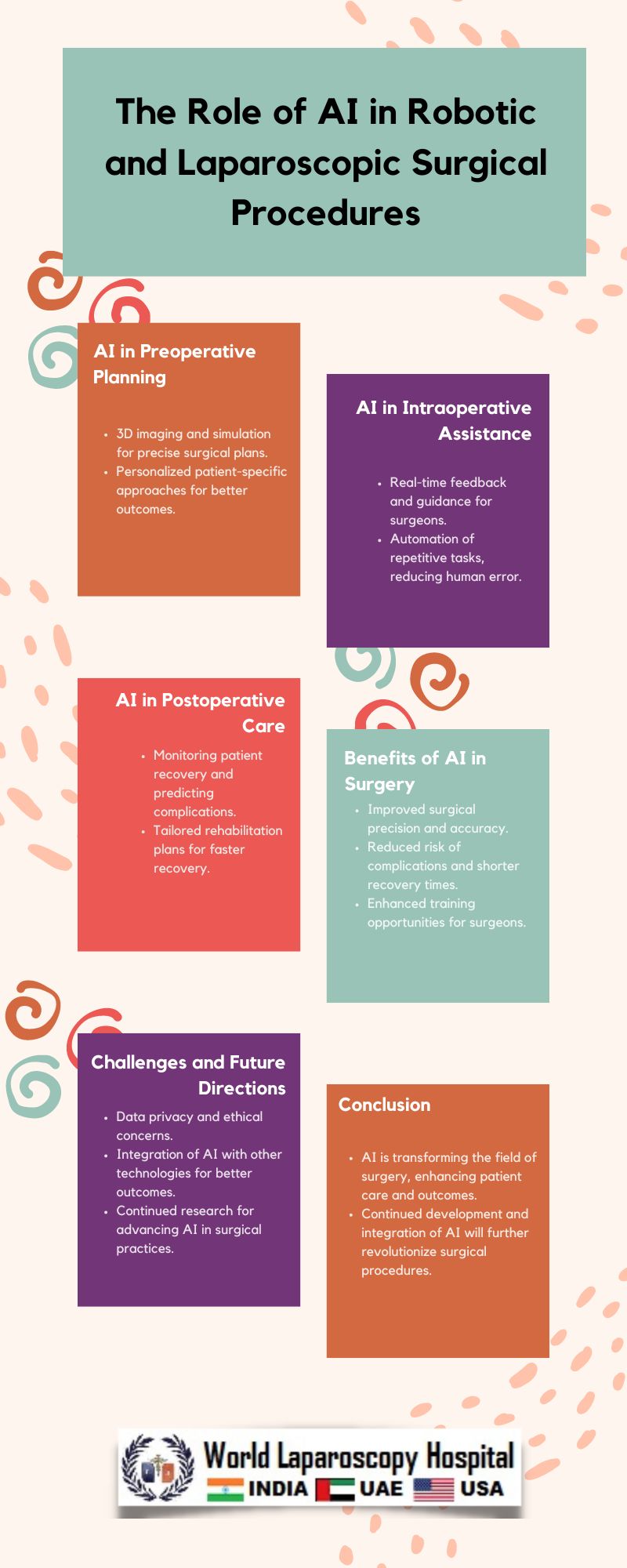Introduction
Surgical procedures have evolved significantly over the past few decades, thanks to advancements in technology. One of the most notable advancements is the integration of artificial intelligence (AI) in robotic and laparoscopic surgeries. AI has revolutionized the field of surgery by enhancing the precision, efficiency, and safety of these procedures. This article explores the role of AI in robotic and laparoscopic surgical procedures, highlighting its benefits, challenges, and future potential.

Robotic Surgery
Robotic surgery, also known as robot-assisted surgery, involves the use of robotic systems to perform surgical procedures. These systems are operated by surgeons who control the robotic arms and instruments from a console. AI plays a crucial role in robotic surgery by providing real-time feedback, enhancing surgical precision, and enabling complex maneuvers.
One of the key advantages of AI in robotic surgery is its ability to analyze and interpret data from various sources, such as imaging scans and patient records. This allows surgeons to plan and execute procedures with greater accuracy and efficiency. For example, AI can help identify optimal surgical pathways, avoid critical structures, and minimize the risk of complications.
Another benefit of AI in robotic surgery is its ability to improve the safety of procedures. AI algorithms can analyze real-time data during surgery, such as blood flow and tissue characteristics, to alert surgeons of potential risks or complications. This real-time feedback enables surgeons to make informed decisions and adjust their approach as needed, ultimately improving patient outcomes.
Furthermore, AI can enhance the training and skills of surgeons. Robotic systems equipped with AI can simulate surgical scenarios, allowing surgeons to practice and refine their techniques in a safe and controlled environment. This not only improves the skills of individual surgeons but also contributes to the overall advancement of surgical practices.
Laparoscopic Surgery
Laparoscopic surgery, also known as minimally invasive surgery, involves performing procedures through small incisions using a camera and specialized instruments. AI has transformed laparoscopic surgery by improving visualization, enabling autonomous actions, and enhancing surgical planning.
One of the primary benefits of AI in laparoscopic surgery is its ability to enhance visualization. AI algorithms can process images from the laparoscope in real time, enhancing the clarity and contrast of the images. This improved visualization allows surgeons to perform procedures with greater precision and accuracy.
AI can also enable autonomous actions in laparoscopic surgery. For example, AI-powered robotic systems can be programmed to perform certain tasks, such as suturing or tissue manipulation, with minimal human intervention. This can reduce the cognitive load on surgeons and improve the efficiency of procedures.
Additionally, AI can enhance surgical planning in laparoscopic surgery. By analyzing preoperative imaging scans and patient data, AI algorithms can help surgeons plan the optimal approach for a procedure. This includes identifying the best incision sites, avoiding critical structures, and optimizing the placement of instruments.
Challenges and Future Potential
While AI has shown great promise in robotic and laparoscopic surgery, there are still challenges that need to be addressed. One of the main challenges is the integration of AI into existing surgical workflows. Surgeons and healthcare providers need to be trained on how to use AI-powered systems effectively, and hospitals need to invest in infrastructure to support AI integration.
Another challenge is the regulatory approval of AI-powered surgical systems. Regulatory bodies need to ensure that these systems meet safety and efficacy standards before they can be used in clinical settings. This requires robust testing and validation processes, which can be time-consuming and expensive.
Despite these challenges, the future potential of AI in robotic and laparoscopic surgery is vast. AI has the potential to further enhance the precision, efficiency, and safety of these procedures. For example, AI-powered robotic systems could eventually perform complex surgeries autonomously, under the supervision of a surgeon. This could revolutionize the field of surgery by reducing the risk of human error and improving patient outcomes.
Conclusion
AI has revolutionized the field of surgery by enhancing the precision, efficiency, and safety of robotic and laparoscopic procedures. AI-powered systems can provide real-time feedback, improve visualization, enable autonomous actions, and enhance surgical planning. While there are challenges to overcome, the future potential of AI in surgery is vast. With continued advancements in technology and research, AI is poised to further transform the field of surgery and improve patient outcomes.